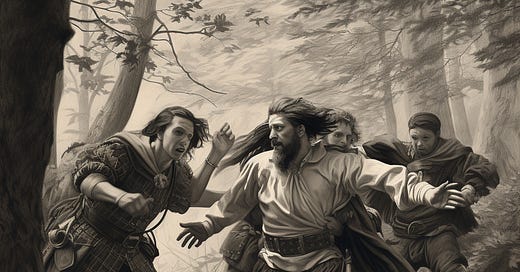The Mysterious Murder of Alexander Menzies
In the quiet, pastoral lands of Scotland, amid the sprawling landscapes of Aberdeenshire, a chilling tale of murder and its aftermath unfolded in the early 17th century. The accused, William Forbes of Monymusk, stood at the center of a tumultuous event that would capture the imagination of many. This is the story of the murder of Alexander Menzies and the intricate legal proceedings that followed.
The Murder in the Shadows
The tale begins on a fateful day, the ninth of May in the year 16**, when the country was still under the rule of King James VI. The victim, Alexander Menzies, was the son of Gilbert Menzies of Culrie, and his story starts with a seemingly mundane task: protecting a hawk's nest. Alexander was directed by his father to visit a halk-neft located within the Craig of Findoun, an area belonging to their heritable land in Aberdeenshire.
Intriguingly, this seemingly straightforward task would become the catalyst for a gruesome series of events. As Alexander made his way to the halk-neft, he was accompanied by a group of tenants from the Findoun lands, tasked with ensuring the nest's security. His mission was to safeguard the hawks for the pleasure and use of the King himself.
However, Alexander had no reason to anticipate that this errand would end in his untimely demise. As he returned from the nest, William Forbes of Monymusk, along with his accomplices, ambushed him near the Cairn of Lorielloun, a burial marker perched on an eminence. This unsuspecting act of aggression led to a cold-blooded murder.
The Ambush
Forbes and his associates had been lying in wait for Alexander behind the Cairn. Concealed in the early morning darkness, they had armed themselves with firearms – culverings, daggers, and pistols – clearly violating the parliamentary prohibition against carrying such weapons. Their intent was sinister.
As Alexander, alone and unaware of the impending danger, passed by the Cairn, Forbes and his men opened fire. With deadly precision, they shot him through the heart and body with two bullets, ending his life in an instant. But the brutality did not end there. As Alexander fell lifeless to the ground, Forbes and his gang descended upon him with their swords and daggers. They ruthlessly inflicted nine ghastly wounds upon his lifeless body.
The Aftermath
In the wake of this horrific event, the community was left in shock and grief. Alexander Menzies, a young man who had set out on a simple task, had been brutally murdered. Questions and outrage swirled around the community, as the gruesome details of the murder emerged.
Legal Proceedings
In the aftermath of the murder, legal authorities took swift action to bring the culprits to justice. The accused, William Forbes of Monymusk, faced charges related to the murder of Alexander Menzies and the theft of his personal belongings. The case was brought before the Scottish legal system, and the proceedings were meticulously recorded in a historic document.
The accused was accused not only of murder but also of violating the parliamentary laws that prohibited carrying and using firearms. His possession and use of culverings, daggers, and pistols were clear infringements of the laws of the time. The legal authorities left no stone unturned, and the accused was summoned to answer for his alleged crimes.
Legal Defense
The accused, William Forbes, did not stand alone. He had a legal defense team in place, consisting of some prominent figures of the time. The defense argued against some of the charges, including the notion of "foirthocht fellonie." The focus of the legal proceedings primarily centered on the murder itself and the accused's possession of prohibited weapons.
The Remission
In a surprising turn of events, William Forbes of Monymusk managed to secure remissions for his alleged crimes. Two separate letters of remission were issued, one on the 27th of June and the other on the 1st of August, both in the same year as the murder. These letters served to pardon the accused for his crimes, further adding intrigue to the tale.
Reparations and Reconciliation
To the shock and dismay of many, the King himself issued these pardons and remissions, pardoning William Forbes of Monymusk for the crimes he was accused of. The accused did not stop there; he also took responsibility for making amends. In a show of remorse and an effort to seek forgiveness, William Forbes offered to make reparations to the family of the victim. This offer was made with the condition that he would satisfy the kin and friends of Alexander Menzies who had not already been satisfied in accordance with the judgment of the Court of Session.
Justice Prevails
Ultimately, justice was served in a way that was uncharacteristic of such heinous crimes in that era. While the accused managed to secure pardons and remissions, the willingness to make reparations demonstrated a commitment to making amends for the wrongdoing. The legal system, in its pursuit of justice, found a way to reconcile the conflicting interests of the accused and the victim's family. It was a resolution that, given the era's norms, was both rare and unexpected.
Conclusion
The tale of the murder of Alexander Menzies and its aftermath is a remarkable historical account of justice and reconciliation. In an era marked by harsh penalties for crimes, the ability to secure pardons and reach a settlement with the victim's family is an unusual twist. William Forbes of Monymusk, the accused, managed to navigate the complex legal system of the time, and despite the grave nature of his alleged crimes, he found a way to seek forgiveness and make amends.





